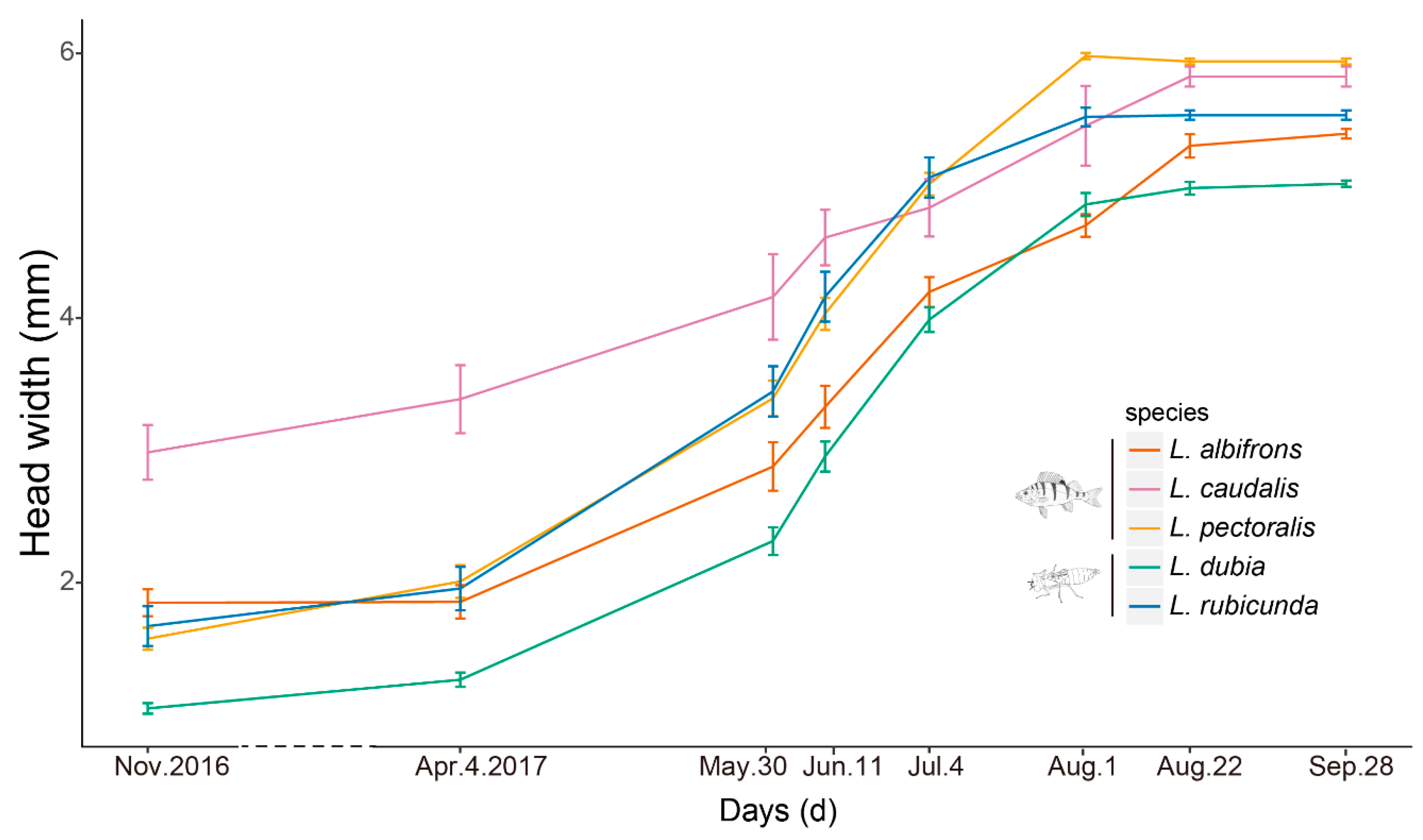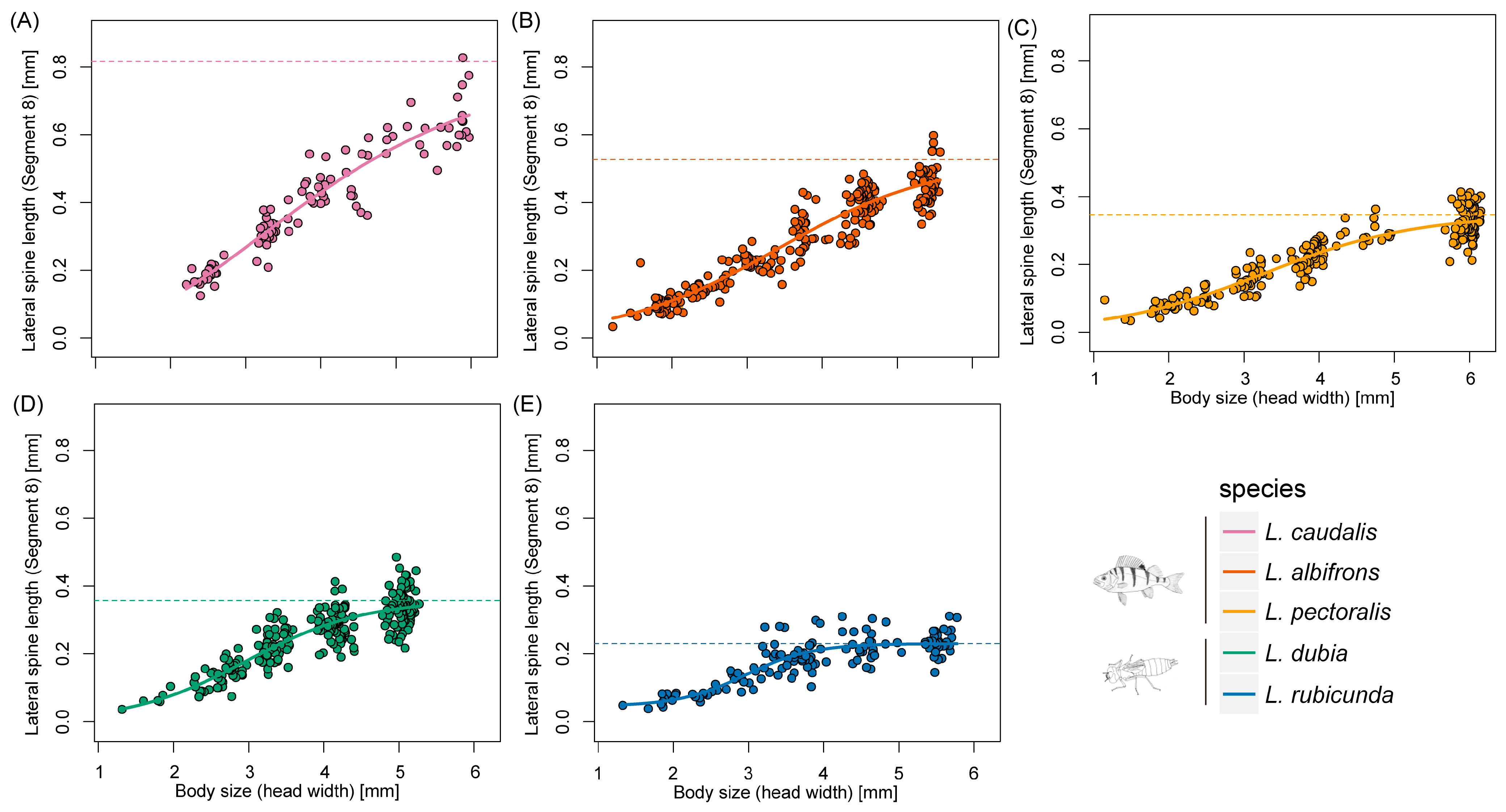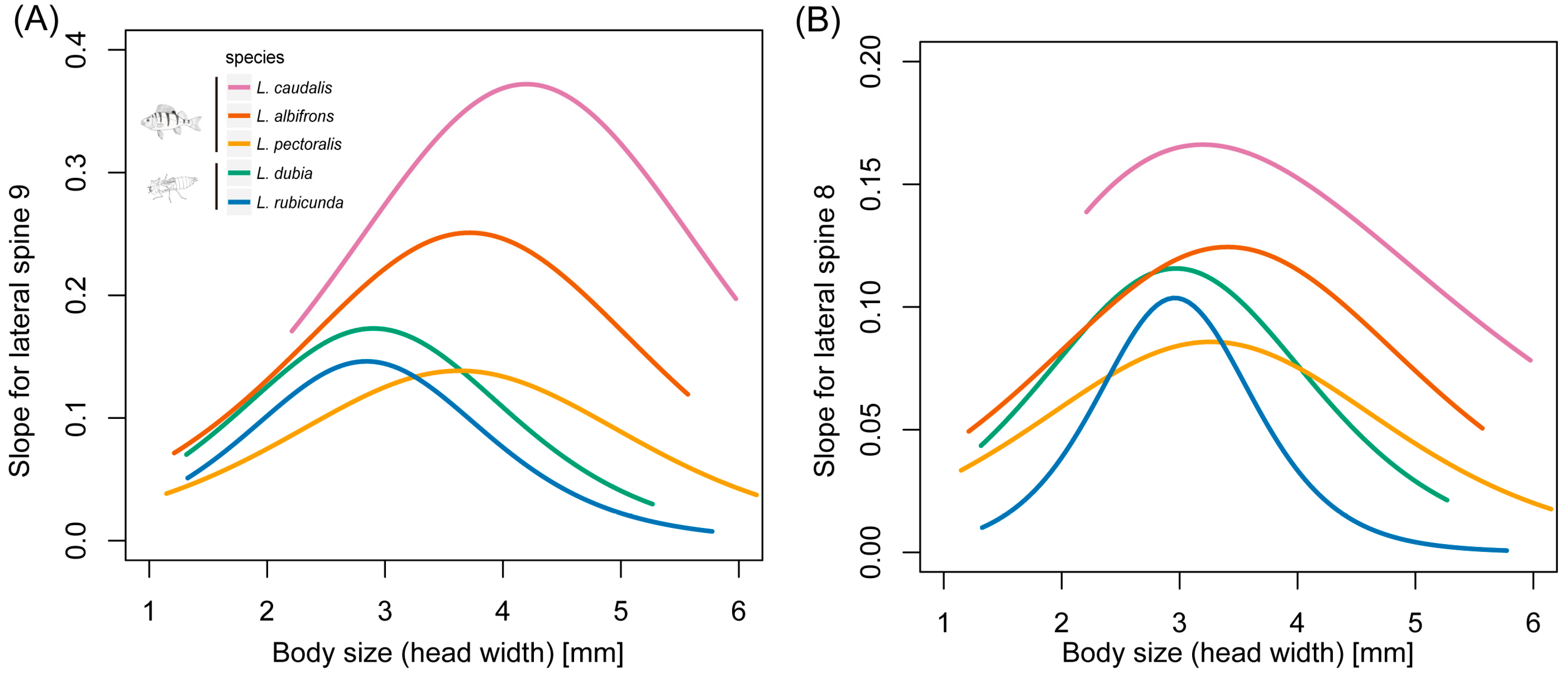Allometry of Defense: Predator Shift Alters Ontogenetic Growth Patterns in an Antipredator Trait
Abstract
:Simple Summary
Abstract
1. Introduction
2. Materials and Methods
2.1. Collecting and Larvae Breeding
2.2. Growth Inspection and Measurements
2.3. Data Analysis
3. Results
4. Discussion
Supplementary Materials
Author Contributions
Funding
Data Availability Statement
Acknowledgments
Conflicts of Interest
References
- McPeek, M.A. Determination of Species Composition in the Enallagma damselfly assemblages of permanent lakes. Ecology 1990, 71, 83–98. [Google Scholar] [CrossRef]
- Sheriff, M.J.; Peacor, S.D.; Hawlena, D.; Thaker, M. Non-consumptive predator effects on prey population size: A dearth of evidence. J. Anim. Ecol. 2020, 89, 1302–1316. [Google Scholar] [CrossRef] [PubMed]
- Schluter, D. Evidence for ecological speciation and its alternative. Science 2009, 323, 737–741. [Google Scholar] [CrossRef] [PubMed]
- Benard, M.F. Predator-induced phenotypic plasticity in organisms with complex life histories. Annu. Rev. Ecol. Evol. Syst. 2004, 35, 651–673. [Google Scholar] [CrossRef]
- Mitchell, M.D.; Bairos-Novak, K.R.; Ferrari, M.C.O. Mechanisms underlying the control of responses to predator odours in aquatic prey. J. Exp. Biol. 2017, 220, 1937–1946. [Google Scholar] [CrossRef] [PubMed]
- Lass, S.; Spaak, P. Chemically induced anti-predator defences in plankton: A review. Hydrobiologia 2003, 491, 221–239. [Google Scholar] [CrossRef]
- Tollrian, R.; Harvell, C.D. The ecology and Evolution of Inducible Defenses; Princeton University Press: Princeton, NJ, USA, 1999. [Google Scholar]
- Jiang, B.; Mikolajewski, D.J. Shift in predation regime mediates diversification of foraging behaviour in a dragonfly genus. Ecol. Èntomol. 2018, 43, 525–533. [Google Scholar] [CrossRef]
- Hoverman, J.T.; Relyea, R.A. How flexible is phenotypic plasticity? developmental windows for trait induction and reversal. Ecology 2007, 88, 693–705. [Google Scholar] [CrossRef]
- West-Eberhard, M.J. Developmental Plasticity and Evolution; Oxford University Press: New York, NY, USA, 2003. [Google Scholar]
- Arnqvist, G.; Johansson, F. Ontogenetic reaction norms of predator-induced defensive morphology in dragonfly larvae. Ecology 1998, 79, 1847–1858. [Google Scholar] [CrossRef]
- Kishida, O.; Trussell, G.C.; Mougi, A.; Nishimura, K. Evolutionary ecology of inducible morphological plasticity in predator–prey interaction: Toward the practical links with population ecology. Popul. Ecol. 2009, 52, 37–46. [Google Scholar] [CrossRef]
- Boege, K.; Marquis, R.J. Facing herbivory as you grow up: The ontogeny of resistance in plants. Trends Ecol. Evol. 2005, 20, 441–448. [Google Scholar] [CrossRef] [PubMed]
- Lu, N.; Sun, Y.; Wei, J.; Gu, L.; Zhang, L.; Yang, Z.; Huang, Y. Toxic Microcystis aeruginosa alters the resource allocation in Daphnia mitsukuri responding to fish predation cues. Environ. Pollut. 2021, 278, 116918. [Google Scholar] [CrossRef]
- Alberch, P.; Gould, S.J.; Oster, G.F.; Wake, D.B. Size and shape in ontogeny and phylogeny. Paleobiology 1979, 5, 296–317. [Google Scholar] [CrossRef]
- Wellborn, G.A.; Skelly, D.K.; Werner, E.E. Mechanisms creating community structure across a freshwater habitat gradient. Annu. Rev. Ecol. Syst. 1996, 27, 337–363. [Google Scholar] [CrossRef]
- Relyea, R.A. The lasting effects of adaptive plasticity: Predator-induced tadpoles become long-legged frogs. Ecology 2001, 82, 1947–1955. [Google Scholar] [CrossRef]
- Dahl, J.; Peckarsky, B.L. Induced morphological defenses in the wild: Predator effects on a mayfly, Drunella Coloradensis. Ecology 2002, 83, 1620–1634. [Google Scholar] [CrossRef]
- Nijhout, H.F.; German, R.Z. Developmental causes of allometry: New models and implications for phenotypic plasticity and evolution. Integr. Comp. Biol. 2012, 52, 43–52. [Google Scholar] [CrossRef]
- Mikolajewski, D.J.; Scharnweber, K.; Jiang, B.; Leicht, S.; Mauersberger, R.; Johansson, F. Changing the habitat: The evolution of intercorrelated traits to escape from predators. J. Evol. Biol. 2016, 29, 1394–1405. [Google Scholar] [CrossRef]
- Salmon, M.; Scholl, J. Allometric growth in juvenile marine turtles: Possible role as an antipredator adaptation. Zoology 2014, 117, 131–138. [Google Scholar] [CrossRef]
- Loy, A.; Bertelletti, M.; Costa, C.; Ferlin, L.; Cataudella, S. Shape changes and growth trajectories in the early stages of three species of the genus Diplodus (Perciformes, Sparidae). J. Morphol. 2001, 250, 24–33. [Google Scholar] [CrossRef]
- Schroeder, L.; Huber, R. Fight strategies differ with size and allometric growth of claws in crayfish, Orconectes rusticus. Behaviour 2001, 138, 1437–1449. [Google Scholar] [CrossRef]
- Murphy, S.M.; Leahy, S.M.; Williams, L.S.; Lill, J.T. Stinging spines protect slug caterpillars (Limacodidae) from multiple generalist predators. Behav. Ecol. 2009, 21, 153–160. [Google Scholar] [CrossRef]
- Vamosi, S.M.; Schluter, D. Character shifts in the defensive armor of sympatric sticklebacks. Evolution 2004, 58, 376–385. [Google Scholar]
- Laske, S.M.; Rosenberger, A.E.; Kane, W.J.; Wipfli, M.S.; Zimmerman, C.E. Top-down control of invertebrates by Ninespine Stickleback in Arctic ponds. Freshw. Sci. 2017, 36, 124–137. [Google Scholar] [CrossRef]
- Zhang, H.; Hollander, J.; Hansson, L.-A. Bi-directional plasticity: Rotifer prey adjust spine length to different predator regimes. Sci. Rep. 2017, 7, 10254. [Google Scholar] [CrossRef]
- Johansson, F.; Mikolajewski, D.J. Evolution of Morphological Defences, in Dragonflies and Damselflies: Model Organisms for Ecological and Evolutionary Research; Cordoba-Aguilar, A., Ed.; Oxford University Press Inc.: New York, NY, USA, 2008; pp. 127–139. [Google Scholar]
- Mikolajewski, D.J.; Johansson, F. Morphological and behavioral defenses in dragonfly larvae: Trait compensation and cospecialization. Behav. Ecol. 2004, 15, 614–620. [Google Scholar] [CrossRef]
- Šigutová, H.; Šigut, M.; Dolný, A. Phenotypic plasticity in specialists: How long-spined larval Sympetrum depressiusculum (Odonata: Libellulidae) responds to combined predator cues. PLoS ONE 2018, 13, e0201406. [Google Scholar] [CrossRef]
- Fleck, G.; Brenk, M.; Misof, B. Larval and molecular characters help to solve phylogenetic puzzles in the highly diverse dragonfly family Libellulidae (Insecta: Odonata: Anisoptera): The Tetrathemistinae are a polyphyletic group. Org. Divers. Evol. 2008, 8, 1–16. [Google Scholar] [CrossRef]
- Jiang, B.; Zhang, Y.; Mauersberger, R.; Schiel, F.; Mikolajewski, D.J. Predation promotes diversification in the mean and variance of antipredator traits. Ecol. Èntomol. 2022, 47, 679–688. [Google Scholar] [CrossRef]
- Hovmöller, R.; Johansson, F. A phylogenetic perspective on larval spine morphology in Leucorrhinia (Odonata: Libellulidae) based on ITS1, 5.8S, and ITS2 rDNA sequences. Mol. Phylogenetics Evol. 2004, 30, 653–662. [Google Scholar] [CrossRef]
- Petrin, Z.; Schilling, E.G.; Loftin, C.S.; Johansson, F. Predators shape distribution and promote diversification of morphological defenses in Leucorrhinia, Odonata. Evol. Ecol. 2010, 24, 1003–1016. [Google Scholar] [CrossRef]
- Mikolajewski, D.J.; Rolff, J. Benefits of morphological defence demonstrated by direct manipulation in larval dragonflies. Evol. Ecol. Res. 2004, 6, 619–626. [Google Scholar]
- Mikolajewski, D.J.; Johansson, F.; Wohlfahrt, B.; Stoks, R. Invertebrate predation selects for the loss of a morphological antipredator trait. Evolution 2006, 60, 1306–1310. [Google Scholar]
- Warren, P.H.; Lawton, J.H. Invertebrate predator-prey body size relationships: An explanation for upper triangular food webs and patterns in food web structure? Oecologia 1987, 74, 231–235. [Google Scholar] [CrossRef] [PubMed]
- Walls, M.; Ketola, M. Effects of predator-induced spines on individual fitness in Daphnia pulex. Limnol. Oceanogr. 1989, 34, 390–396. [Google Scholar] [CrossRef]
- Gill, A.B. The dynamics of prey choice in fish: The importance of prey size and satiation. J. Fish Biol. 2003, 63, 105–116. [Google Scholar] [CrossRef]
- Price, S.A.; Friedman, S.T.; Wainwright, P.C. How predation shaped fish: The impact of fin spines on body form evolution across teleosts. Proc. R. Soc. B: Boil. Sci. 2015, 282, 20151428. [Google Scholar] [CrossRef]
- Benke, A.C. A Method for comparing individual growth Rates of Aquatic Insects with Special Reference to the Odonata. Ecology 1970, 51, 328–331. [Google Scholar] [CrossRef]
- R Core Team. R: A Language and Environment for Statistical Computing; R Foundation for Statistical Computing: Vienna, Austria, 2023; Available online: http://www.R-project.org (accessed on 21 April 2023).
- Orme, D. The Caper Package: Comparative Analysis of Phylogenetics and Evolution in R; R Development Core Team, 2013. [Google Scholar]
- Paine, C.E.T.; Marthews, T.R.; Vogt, D.R.; Purves, D.; Rees, M.; Hector, A.; Turnbull, L.A. How to fit nonlinear plant growth models and calculate growth rates: An update for ecologists. Methods Ecol. Evol. 2011, 3, 245–256. [Google Scholar] [CrossRef]
- Hambright, K.D. Experimental analysis of prey selection by largemouth bass: Role of predator mouth width and prey body depth. Trans. Am. Fish. Soc. 1991, 120, 500–508. [Google Scholar] [CrossRef]
- Moodie, G.E.E. Predation, natural selection and adaptation in an unusual threespine stickleback. Heredity 1972, 28, 155–167. [Google Scholar] [CrossRef]
- Nilsson, P.A.; Brönmark, C. Prey vulnerability to a gape-size limited predator: Behavioural and morphological impacts on northern pike piscivory. Oikos 2000, 88, 539–546. [Google Scholar] [CrossRef]
- Dewitt, T.J.; Sih, A.; Hucko, J.A. Trait compensation and cospecialization in a freshwater snail: Size, shape and antipredator behaviour. Anim. Behav. 1999, 58, 397–407. [Google Scholar] [CrossRef] [PubMed]
- Relyea, R.A. Morphological and behavioral plasticity of larval anurans in response to different predators. Ecology 2001, 82, 523–540. [Google Scholar] [CrossRef]
- McCauley, S.J. The effects of dispersal and recruitment limitation on community structure of odonates in artificial ponds. Ecography 2006, 29, 585–595. [Google Scholar] [CrossRef]






| Species | L. dubia | L. rubicunda | L. caudalis | L. albifrons | L. pectoralis | |||||
|---|---|---|---|---|---|---|---|---|---|---|
| Spines | L9 | L8 | L9 | L8 | L9 | L8 | L9 | L8 | L9 | L8 |
| monomolecular | −650.8 | −802.2 | −359.7 | −456.9 | NA | −256.8 | NA | −769.7 | −641.1 | −736.1 |
| 3-parameter logistic | −674.2 | −824.6 | −377.2 | −480.0 | −240.3 | −283.3 | −585.1 | −799.6 | −685.1 | −774.4 |
| 4-parameter logistic | −672.3 | −822.6 | −375.1 | −482.4 | −238.4 | −281.7 | −584.0 | −798.6 | −683.9 | −774.3 |
| Gompertz | −673.1 | −823.8 | −375.5 | −474.1 | −239.4 | −284.0 | −577.0 | −794.3 | −679.6 | −768.8 |
| linear | −636.9 | −792.8 | −343.5 | −437.8 | −205.4 | −256.3 | −549.7 | −767.3 | −640.3 | −725.5 |
| linear without intercept | −627.3 | −779.2 | −339.5 | −439.7 | −54.7 | −217.4 | −369.6 | −696.8 | −550.0 | −718.5 |
| exponential | −627.3 | −761.2 | −312.8 | −414.9 | −153.1 | −228.9 | −445.1 | −687.4 | −568.6 | −677.9 |
Disclaimer/Publisher’s Note: The statements, opinions and data contained in all publications are solely those of the individual author(s) and contributor(s) and not of MDPI and/or the editor(s). MDPI and/or the editor(s) disclaim responsibility for any injury to people or property resulting from any ideas, methods, instructions or products referred to in the content. |
© 2023 by the authors. Licensee MDPI, Basel, Switzerland. This article is an open access article distributed under the terms and conditions of the Creative Commons Attribution (CC BY) license (https://creativecommons.org/licenses/by/4.0/).
Share and Cite
Jiang, B.; Yao, Y.; Mauersberger, R.; Mikolajewski, D.J. Allometry of Defense: Predator Shift Alters Ontogenetic Growth Patterns in an Antipredator Trait. Insects 2023, 14, 712. https://doi.org/10.3390/insects14080712
Jiang B, Yao Y, Mauersberger R, Mikolajewski DJ. Allometry of Defense: Predator Shift Alters Ontogenetic Growth Patterns in an Antipredator Trait. Insects. 2023; 14(8):712. https://doi.org/10.3390/insects14080712
Chicago/Turabian StyleJiang, Bin, Yu Yao, Rüdiger Mauersberger, and Dirk J. Mikolajewski. 2023. "Allometry of Defense: Predator Shift Alters Ontogenetic Growth Patterns in an Antipredator Trait" Insects 14, no. 8: 712. https://doi.org/10.3390/insects14080712





